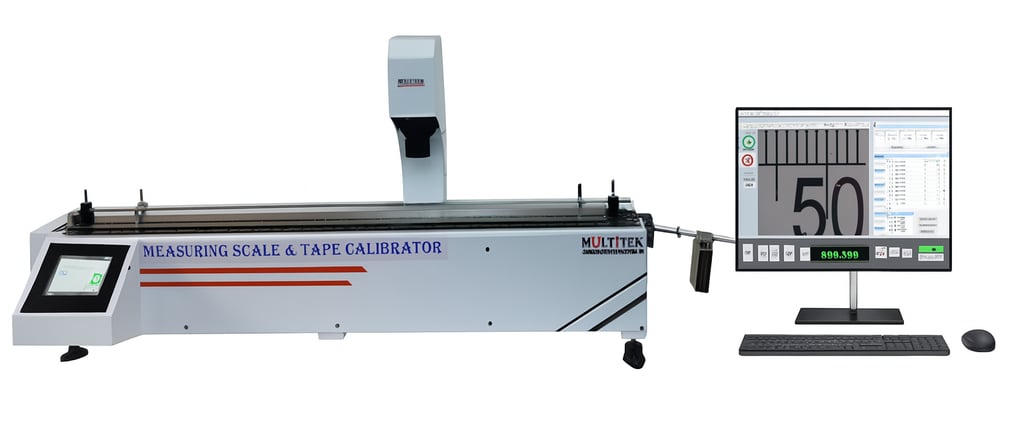Keep It True: The Essentials of Measuring Scale and Tape Calibration
Measuring tools are the foundation of quality and accuracy. Treating scale and tape calibration as a routine maintenance task, not an optional expense, is the hallmark of a professional and reliable operation.
Admin
8/17/20253 min read


In any field that relies on accuracy—from construction and manufacturing to scientific research and quality control—the tools used for measurement are fundamental. A ruler, tape measure, or weighing scale might seem like a simple device, but if it's not calibrated correctly, the resulting measurements are meaningless and can lead to costly errors, wasted materials, or even safety hazards.
Calibration isn't just a technical requirement; it's a commitment to precision and reliability.
What Exactly is Calibration?
Calibration is the process of comparing a measuring instrument—like a scale or a tape measure—to a known, traceable standard.
The primary goal is twofold:
To confirm that the instrument is measuring accurately within specified tolerances.
To adjust the instrument back to the required standard if it is found to be inaccurate.
When we talk about traceability, we mean that the standard being used for comparison can be linked, through an unbroken chain of comparisons, back to national or international standards. This ensures consistency across different locations and industries.
The Importance of Calibrating Scales (Mass Measurement)
Weighing scales—whether they're micro-balances in a lab or heavy-duty industrial scales—are subject to environmental factors, wear and tear, and drift over time.
Common Scale Calibration Issues:
Drift: Components, especially the load cell, can slowly change their electrical resistance or mechanical properties, causing the output reading to stray from the true value.
Temperature & Humidity: Environmental changes can affect the load cell's performance and the physical characteristics of the scale's internal components.
Physical Shock: Dropping or overloading the scale can permanently damage the load cell or internal mechanism.
Zero-Point Error: Even basic scales can "drift" and not return exactly to zero when unloaded, requiring an adjustment.
The Calibration Process for Scales:
Typically, a technician uses certified, traceable calibration weights to check the scale at multiple points across its weighing capacity (e.g., 25%, 50%, 75%, and 100% capacity). If the scale's reading deviates from the known weight, it is electronically or mechanically adjusted until the readings match the standard within the acceptable tolerance.
The Importance of Calibrating Tapes and Rulers (Linear Measurement)
Tape measures and rulers, while seemingly robust, are susceptible to issues that compromise linear measurement accuracy.
Common Tape Calibration Issues:
End-Hook Error: This is the most common issue. The small metal tab (the end-hook) at the beginning of a tape measure can bend, wear out, or become loose. Since measurements are often taken by either hooking the end-hook over an object or pushing it flush against a surface, even a small error here translates directly into an inaccurate measurement.
Temperature Effects: While minor for short-term use, metal tapes are designed to be accurate at a specific reference temperature (often 68∘F or 20∘C). Extreme temperatures can cause the tape material to expand or contract, slightly altering its true length.
Tension/Sag: When measuring long distances with a non-supported tape (especially steel tapes), the weight of the tape itself can cause it to sag. The amount of tension applied by the user must be controlled and corrected for.
Wear and Tear: Faded markings, kinks, or stretching in non-metallic tapes can lead to reading errors.
The Calibration Process for Tapes
Calibration of long tapes is often performed using a bench comparator—a long, rigid piece of equipment with precision-etched marks that serve as the traceable standard. The tape is laid out, often with a specific tension applied, and its markings are compared against the standard's markings at various intervals to identify and document any deviations. For tapes used in surveying or highly accurate work, correction factors are often issued on a certificate rather than physically adjusting the tape itself.
When and How Often Should You Calibrate?
There is no one-size-fits-all answer, but typical scenarios that trigger calibration include:
Periodic Intervals: This is the most common. Based on the instrument's usage, criticality, and history, most scales and tapes are calibrated annually.
After Repair or Maintenance: Any work done on an instrument's internal components (e.g., replacing a load cell) requires immediate re-calibration.
After Physical Trauma: If the instrument has been dropped, overloaded, or exposed to harsh conditions, it should be checked.
Before a Critical Project: If a project requires exceptionally tight tolerances, calibrating the equipment beforehand is a necessary quality assurance step.
The Takeaway
Measuring tools are the foundation of quality and accuracy. Treating scale and tape calibration as a routine maintenance task, not an optional expense, is the hallmark of a professional and reliable operation. Accurate measurements save time, money, and reputations. Don't just measure—measure correctly.
Any requirement, please contact?
INDIA Development Center
201-208, 2nd Floor, Shri Krishna Complex, Opp. Gate No. 2,
Mahesh Apartments, Vasundhara Enclave,
Main Road, New Delhi–110096
Websites: www.multitek.in | www.microvicker.com | www.mcpl.ai | www.scaletape.com | www.makemyspm.com | www.ucihardness.com
Tel : 011-41009005 | Mob : +91-7836009222, 7836009922
Email : service@multitek.in
